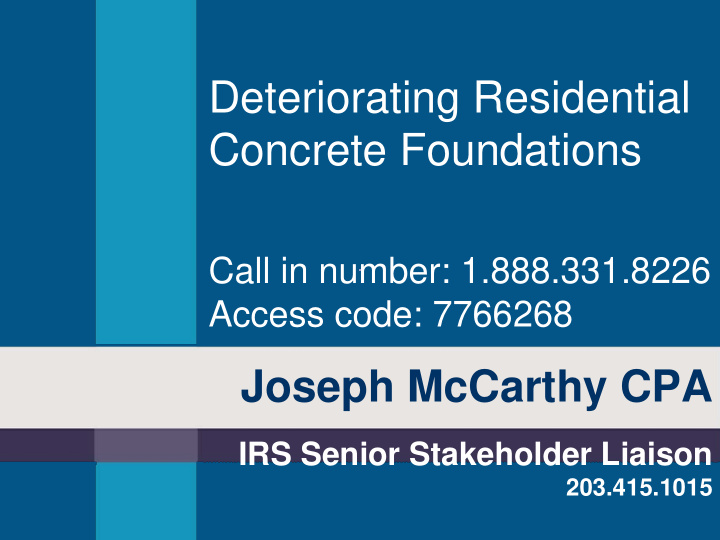



Deteriorating Residential Concrete Foundations Call in number: 1.888.331.8226 Access code: 7766268 Joseph McCarthy CPA IRS Senior Stakeholder Liaison 203.415.1015
Casualty loss defined A casualty is damage, destruction, or loss of property that results from an identifiable event that is sudden, unexpected, and unusual. Damage or loss resulting from progressive deterioration of property through a steadily operating cause is not a casualty loss. Revenue Procedure 2017-60 Section 2.05
How to qualify for the safe harbor The safe harbor under this revenue procedure is available to a taxpayer who has: • obtained a written evaluation from a licensed engineer indicating that the foundation was made with defective concrete, and …. Rev Proc 2017-60 Section 4.01
How to qualify for the safe harbor (continued) • has requested and received a reassessment report that shows the reduced reassessed value of the residential property based on the written evaluation from the engineer and an inspection pursuant to Connecticut Public Act No. 16-45. Rev Proc 2017-60 Section 4.01
How to qualify for the safe harbor The safe harbor also is available to a taxpayer: • whose personal residence is … in Connecticut … provided the taxpayer has obtained a written evaluation from a licensed engineer indicating that the foundation was made with defective concrete containing the mineral pyrrhotite. Rev Proc 2017-60 Section 4.01
Casualty loss limitations A casualty loss deduction is allowable only for the amount of the loss that exceeds $100 per casualty. Second, the net amount of all of a taxpayer’s casualty losses (in excess of casualty gains, if any) is allowable only for the amount of the losses that exceeds 10 percent of the taxpayer’s adjusted gross income (AGI) for the year. Rev Proc 2017-60 Section 2.09
Casualty loss limitations The amount of a taxpayer’s loss resulting from the deteriorating concrete foundation is limited to the taxpayer’s adjusted basis in the property. In addition, the amount of the loss may be limited depending on whether the taxpayer has a pending claim for reimbursement … Rev Proc 2017-60 Section 4.02
Casualty loss limitations A taxpayer who does not have a pending claim for reimbursement, and who does not intend to pursue reimbursement, may claim as a loss all unreimbursed amounts (subject to the adjusted basis limitation) paid during the taxable year to repair damage to the taxpayer’s personal residence caused by the deteriorating concrete foundation. Rev Proc 2017-60 Section 4.02
Casualty loss limitations A taxpayer who has a pending claim for reimbursement, or who intends to pursue reimbursement, may claim a loss for 75 percent of the unreimbursed amounts paid during the taxable year to repair damage to the taxpayer’s personal residence caused by the deteriorating concrete foundation. Rev Proc 2017-60 Section 4.02
Casualty loss limitations Only amounts paid to restore the taxpayer’s personal residence to the condition existing immediately prior to the damage qualify for loss treatment. Rev Proc 2017-60 Section 4.03
Casualty loss not allowed Taxpayers who choose not to apply the safe harbor treatment provided by this revenue procedure are subject to all of the generally applicable provisions governing the deductibility of losses under § 165. Rev Proc 2017-60 Section 4.05
Claiming the casualty loss A taxpayer claiming a casualty loss under this revenue procedure must report the amount of the loss on Form 4684 (“Casualties and Thefts”) and must mark “Revenue Procedure 2017- 60” at the top of that form. Rev Proc 2017-60 Section 4.04
Claiming the casualty loss This revenue procedure is effective for federal income tax returns (including amended federal income tax returns) filed after November 21, 2017. Revenue Procedure 2017-60 section 5
Timing of payments If a taxpayer pays to repair damage to that taxpayer’s personal residence caused by a deteriorating concrete foundation during the taxpayer’s 2016 taxable year or earlier, the taxpayer may treat the amount paid as a casualty loss on a timely Amended U.S. Individual Income Tax Return (Form 1040X) for the taxable year of payment. Rev Proc 2018-14 section 3.01
Timing of payments: 2017 tax year If a taxpayer pays to repair the damage during the taxpayer’s 2017 taxable year or prior to a timely filed (including extensions) original U.S. Individual Income Tax Return (Form 1040, 1040A or 1040EZ) for the 2017 taxable year, the taxpayer may treat the amount paid as a casualty loss on the taxpayer’s original 2017 income tax return or a timely filed Form 1040X for the 2017 taxable year). R ev Proc 2018-14 sec 3.01
Timing of payments - 2018 If a taxpayer pays to repair the damage after filing an original 2017 income tax return and prior to the last day for filing a timely Form 1040X for the 2017 taxable year, the taxpayer may treat the amount paid as a casualty loss on a timely filed Form 1040X for the 2017 taxable year. Rev Proc 2018-14 section 3.01
References • Revenue Procedure 2017-60 • Revenue Procedure 2018-14
Questions ?
Recommend
More recommend